Aviation Law in Asia: Emerging Trends and Challenges
Introduction to Aviation Law in Asia
Aviation law in Asia is a dynamic and rapidly evolving field, reflecting the region's growing importance in the global aviation industry. With Asia projected to become the largest aviation market in the coming years, understanding the emerging trends and challenges in this area is crucial for stakeholders. This blog post explores the current landscape of aviation law in Asia, highlighting key developments and potential obstacles.

Growth and Expansion of the Aviation Industry
The aviation sector in Asia has experienced significant growth over the past decade. This expansion is driven by an increase in air travel demand, economic growth, and a burgeoning middle class. As more people take to the skies, Asian countries are investing heavily in airport infrastructure and fleet expansion to accommodate this surge. However, this rapid growth presents unique challenges in terms of regulatory compliance and safety standards.
Regulatory bodies across Asia are working diligently to create a unified framework that ensures safety and efficiency. This involves harmonizing regulations with international standards set by organizations like the International Civil Aviation Organization (ICAO). Compliance with these standards is essential to maintain safety, security, and environmental sustainability.
Challenges in Regulatory Harmonization
One of the primary challenges in Asian aviation law is achieving regulatory harmonization across diverse jurisdictions. Countries in Asia have varying legal systems, cultural contexts, and economic priorities, which can complicate efforts to standardize regulations. This lack of uniformity can lead to inefficiencies and legal uncertainties for airlines operating across multiple countries.
Efforts are being made to address these challenges through regional cooperation and multilateral agreements. Organizations such as the Association of Southeast Asian Nations (ASEAN) are playing a pivotal role in fostering collaboration among member states to streamline regulations and improve air connectivity.

Environmental Concerns and Aviation
Environmental sustainability is another pressing issue facing the aviation industry in Asia. With increased air traffic comes a heightened focus on reducing carbon emissions and minimizing environmental impact. Asian countries are adopting various measures to address these concerns, such as investing in fuel-efficient aircraft, improving air traffic management, and exploring alternative fuels.
Moreover, governments are implementing stricter environmental regulations to ensure that the growth of the aviation sector does not come at the expense of ecological balance. This includes enforcing noise regulations, emissions standards, and promoting green airport initiatives.
Technological Advancements and Innovation
Technological advancements are reshaping the aviation landscape in Asia, offering new opportunities and challenges. The integration of digital technologies, such as artificial intelligence, blockchain, and the Internet of Things (IoT), is revolutionizing airline operations, passenger experience, and safety protocols.

However, these innovations also pose regulatory challenges as existing laws may not adequately address new technologies. Policymakers must adapt quickly to ensure that regulations keep pace with technological developments while fostering innovation and maintaining safety standards.
Conclusion
The landscape of aviation law in Asia is undergoing significant transformation as countries adapt to the demands of a growing aviation market. By addressing challenges related to regulatory harmonization, environmental sustainability, and technological innovation, Asian nations can ensure a robust and resilient aviation sector. Stakeholders must remain vigilant and proactive in navigating these changes to capitalize on the opportunities that lie ahead.
